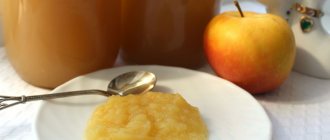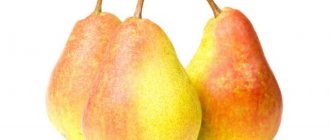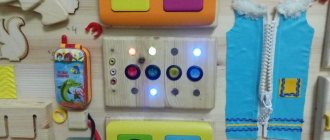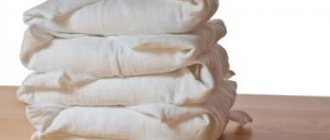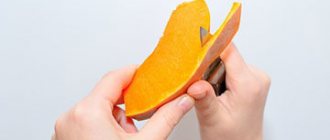The introduction of new products into a baby's diet is a crucial moment for both parents and the child. It is necessary to take into account many important points so that complementary foods are useful, the baby likes them and does not cause an allergic reaction. Today you can find any fruits and vegetables in stores all year round, which on the one hand makes you happy, but on the other hand makes the selection process difficult. It is better to select healthy and necessary products for the baby’s growing body together with a pediatrician. For infants, apple puree, vegetable puree, and pumpkin puree are good options. But banana puree is worth preparing for a child if he is behind in weight gain, suffers from rickets and needs additional vitamins. This once rare exotic fruit of the banana tree is today always on sale at a very affordable price. You will learn how to make banana puree for your child in this article.
How to make banana puree for babies in a blender
For baby food, we use only ripe, undamaged banana fruit. Be sure to inspect it; there should be no large black spots on it. Severely overripe fruits should also be excluded. Peel the banana in the usual way.
We will grind the banana for puree in two stages: first, using a blender. Place sliced bananas in a bowl.
Turn banana into puree.
Since there may still be small unchopped pieces in the puree, we will pass additional banana mass through a sieve.
Add milk (warm, boiled) to the banana mixture.
We wipe the ingredients.
Banana for babies, made at home, ready.
This type of complementary food should be used immediately, so let’s start feeding right away. Bon appetit to your kids!
Banana puree is not only a tasty and healthy stand-alone dish, but also a base for homemade baking, cocktails, ice cream and desserts. Starting from the age of six months, this sweet delicacy can be offered to infants as complementary foods, in its pure form or added to porridge. And mashed bananas are a great help in fighting coughs for both children and adults. This medicine is not only tasty, but also effective. We'll tell you how to make banana puree in our article.
Cooking recipes
Many baby food suppliers sell ready-made banana puree for babies today. It is available in different packaging and with different additives. But, despite the fervent belief that the product is made without added sugar and preservatives, this statement cannot be completely trusted. And for your beloved child you want all the best and most useful. Therefore, it is better to open our website and see how to make banana puree with your own hands.
Fresh banana puree
The easiest way is to grate the banana pulp on a plastic grater and then pass it through a sieve with a little warm water or breast milk. This banana puree will delight your child, it is tasty, satisfying and healthy. You can read about the benefits of this fruit, as well as at what age it is best to give banana puree here.
Baked Banana Puree
A fresh banana has many useful qualities, but for the first time it is better to give the baby the dish after heat treatment. And in order to preserve all the useful components as much as possible, we bake the banana in the oven. One medium banana will require about half a glass of water. A clean, healthy fruit, without removing the peel, is placed on a dish previously covered with wax paper. The oven is heated to a temperature of no more than 120*C, and the banana is baked for only 15 - 20 minutes. With this regimen, the maximum amount of vitamins and microelements is preserved, and possible microorganisms are easily destroyed. The finished dish is laid out on a plate and cleaned right in it, as the banana will release a lot of tasty juice. The pulp is kneaded with a fork and the baked banana puree is ready. It turns out very tasty, and even adult family members will not refuse such a dessert.
Delicious recipe! How to brew a series correctly
Banana-apple puree
Banana goes well with many fruits and vegetables. Banana puree for babies has an excellent taste, the recipe for which includes the addition of melon, lemon, apple or kiwi. Moreover, this assortment stores well if it is prepared correctly. To prepare you will need:
- One ripe banana, medium size;
- Two yellow apples;
- A tablespoon of sugar;
- Half a glass of water.
- Wash the apples and cut into medium pieces without removing the peel. Pour in water and bring to a boil. Simmer over low heat for 5 – 7 minutes until they become soft. Then rub through a sieve to remove all excess.
- Peel the banana, leaving the fibers that are between the skin and pulp. Cut into small pieces and add to the applesauce along with sugar. Keep everything on low heat for 3 – 4 minutes.
- Cool and beat with a blender.
- Place in prepared sterilized jars, cover, but do not close the lids, and keep in a steam bath for 15 minutes.
- Close the jars, turn them over and leave them to cool under a warm blanket.
Calories and nutritional value
Banana puree is made from the pulp of the fruit. The taste of the delicacy primarily depends on the variety and ripeness of the fruit. When choosing, it is advisable to pay attention to the fact that the skin of the fruit is bright yellow, without black spots. The calorie content of puree made from ripe banana is 89 kcal. It contains 1.5 g of protein, 0.1 g of fat and 21 g of carbohydrates per 100 grams.
Bananas are a source of vitamins and minerals important for the body. It is safe to say that puree from this fruit helps improve the functioning of the liver, heart and brain, especially in old age. Bananas contain vitamins E, K, C, PP and group B. The latter help the body fight fatigue, insomnia and bad mood.
Bananas contain minerals such as potassium, calcium, magnesium, sodium, phosphorus, zinc and others. Due to its high nutritional value, this product should be present in the diet of every healthy person.
When can you give it to your baby?
The first step is to decide at what age banana puree can be used to feed infants.
Pediatricians all over the world agree that it is better to introduce new foods to babies under one year old with vegetable purees. Only after their successful assimilation can you start eating fruits, in particular bananas. This is due to the fact that:
- the sweet taste of fruit purees can discourage a child from eating tasteless vegetable additives;
- Bananas contain sucrose, which at first can have a negative effect on the gastric mucosa, which cannot be said, for example, about potatoes or zucchini.
Delicious recipe! What can you cook from yesterday's buckwheat porridge?
Breastfed babies begin to add vegetables to their diet from six months. And only after this, in the eighth month, can you give banana puree. For infants on artificial nutrition, complementary foods are introduced at an earlier stage. From four months they are introduced to carrots, zucchini, onions, potatoes, and from the age of six months they try fruits.
Beneficial features
Banana puree is obtained by mechanical processing of fruit pulp. That is why this dessert has beneficial properties similar to whole fruits:
- supplies the body with energy;
- thanks to the content of dietary fiber, it helps to cope with constipation;
- optimizes intestinal function;
- helps get rid of cramps in the calf muscles;
- provides prevention of stress caused by lack of sleep;
- effectively fights cancer cells;
- helps reduce body temperature during fever;
- increases the level of hemoglobin in the blood;
- removes toxins from the body;
- improves digestion;
- lifts the mood.
Bananas are easily digestible and do not cause allergies. That is why they are offered in crushed form as one of the first foods.
Like puree for babies
Starting from the age of six months, this dessert is introduced into the diet of babies. It is recommended to introduce a new dish in the first half of the day. First, the child should be offered half a teaspoon, and then, observing his reaction, gradually increase the serving size.
To prepare a one-component puree for your baby, you need to wash a ripe banana, peel it, cut off the edges and chop the fruit with a fork or blender. Then add a little breast milk or formula to achieve the desired consistency.
If the reaction of the child’s body from the digestive system is positive, you can gradually offer the child a multi-component puree, for example, banana-apple puree. It's also easy to prepare. Half an apple should be peeled and cored, cut into cubes and filled with 50 ml of water. Boil the fruit slices for about 7 minutes and cool. Then add half a banana to the apple and grind the ingredients using a blender. If necessary, add milk or water.
What can you combine with?
Banana puree goes well with a variety of foods to add nutrients and add variety to your menu.
It can be added to the following products:
- milk porridge. To do this, you need to cook fresh porridge, cool it to room temperature and add fresh puree;
- cottage cheese. This product, together with banana, makes a healthy curd dessert. Recommended for children from nine months;
- applesauce. Both ingredients are mixed into a homogeneous mass, and the result is a vitamin dessert;
- yogurt. You can take factory-made children's yogurt according to age or prepare it yourself from sourdough and milk. In combination with a banana, yogurt will not be sour and is perfect for your baby as a snack.
Banana puree is considered one of the healthiest supplements for infants. It gives the child's body a large boost of vitamins and energy. However, the decision at what age to start giving it to the baby is made by the parents. And in this matter, they should rely not only on generally accepted opinion, but also take into account the individual characteristics of their child’s development in conjunction with the pediatrician’s recommendations.
The banana puree recipe is simple even for those who don’t know how or don’t like to cook.
More tasty and healthy for babies and nursing mothers: RECIPES
Dish
Kitchen
Preparation time
| Vegetarian, Puree, Fruit | 6 months, Up to a year | 2 |
Cooking time
Portions
- 1 piece banana, ripe banana without darkening
Dish
Kitchen
Preparation time
| 3 | Vegetarian, Puree, Fruit | 6 months, Up to a year | 2 |
Cooking time
Portions
- 1 piece banana, ripe banana without darkening
It is better to give puree for the first time in the first half of the day, so that during the day you can track the child’s body’s reaction to the new product.
! Recommendation: Do not use sugar, salt and spices in children's dishes.
This recipe is ideal for feeding a baby, but will be an excellent dish for children of any age.
All information posted on the site is for informational purposes only and cannot be used for self-medication. Having acquired specific applied knowledge, do not experiment with the child’s health. If symptoms of the disease appear, immediate assistance from a specialist is necessary.
Useful preparations for the winter
You can buy bananas in the store at any time of the year. If for some reason this is impossible to do, we offer two ways to prepare banana puree for the winter:
- Squeeze the juice from two lemons and pour it over peeled bananas (1 kg) and 2 apples. Grind the fruits using a blender and transfer the resulting puree to an enamel pan. Add 600 g sugar and 400 ml water. Boil the puree over low heat for 30 minutes, then pour into sterilized jars and seal with a canner.
- The second method involves freezing banana puree for the winter. To do this, bananas are crushed in a blender. Then the finished puree is mixed with lemon juice so that it does not darken. For 250 ml of preparation you should take a tablespoon of juice. In an airtight container, the puree is stored in the freezer for a period of no more than 4 months.
Banana puree for cough recipe
In folk medicine, bananas are known as an effective remedy for treating severe coughs. To do this, they are crushed to a puree and combined with other useful ingredients. The result is a tasty medicine that allows you to get rid of a cold in a few days.
You can make banana puree, just like for babies, using a blender. And the recipes for preparing medicine based on it are as follows:
- Banana and honey. To the freshly prepared puree, add a teaspoon of honey and a glass of boiling water, stir and let it brew for 30 minutes. Take the medicine 50 ml every 3 hours.
- Banana and cocoa. To prepare the following traditional medicine, you need to peel and puree one ripe fruit using a blender, fork or any other device. Add cocoa powder (6 tsp), hot milk (200 ml) to the resulting mass and mix. You should take the medicine before going to bed for 5 days.
- Banana and milk. Pour boiling milk (100 ml) over the fruit mashed with a fork. Then add to it a teaspoon of sugar or honey and the same amount of butter. Beat with a blender until smooth. Take once a day until the cough goes away.
Thanks to these simple recipes, dealing with a cold will be much easier, tastier and faster.
Contraindications for use
Bananas and puree made from them cannot in any way be called products that can cause harm to the body. As an exception, only their individual intolerance should be noted. In addition, people who have the following contraindications should limit their consumption of banana puree:
- overweight;
- diabetes;
- allergy;
- digestive disorders.
For other people, including children, bananas in whole and crushed to a puree consistency can be consumed every day, as they are very beneficial for the body.
All children adore the tasty and satisfying yellow exotic crescent. The sweet banana pulp, without seeds or segments, is whole, aromatic, gives indescribable pleasure and brings many benefits to the little person’s body. Absolutely hypoallergenic, it is perfect for baby food. Naturally, parents are interested in the age at which bananas should be introduced into infant feeding.
All children love bananas, but little ones need to introduce them into complementary foods gradually.
How to start complementary feeding
You can start complementary feeding with a banana in several variations:
- homemade puree;
- factory made banana puree;
- adding banana to milk mixture;
- adding banana to baby porridge.
The last two options are more suitable for those children who often have allergies. Therefore, it is dangerous to give the fruit in its pure form.
Healthy children with normal stools are given half a teaspoon of banana on the first day. Observe the reaction of the skin and stool. If the baby does not have constipation or allergic reactions, the dose can be repeated the next day. According to this principle, feeding continues for a week, after which the dosage is gradually increased. By 10 months, the child can already eat up to half of the fruit.
What beneficial substances are contained in bananas?
In addition to being hypoallergenic, banana boasts its rich composition. Tropical fruit contains:
- The most important vitamins and microelements that support the proper development of all systems of the baby. Thanks to the presence of fluorine, potassium, magnesium, sodium, heart function improves, vitamins enrich the composition of the blood, minerals form bone and muscle tissue.
- The fruit consists of 20% starch, which serves as a supplier of glucose. Once in the body, it is easily broken down, ensuring good absorption of the product and supplying the glucose necessary for the overall development of the baby.
- B vitamins are needed by the baby’s nervous system; they are involved in the formation of skin and hair cells and are responsible for the baby’s restful sleep.
- Fiber is a source of energy and an element that has a positive effect on the child’s digestive system.
- The combination of all the beneficial substances of the fruit affects concentration. The fruit has the ability to lift spirits, reducing the whims of infants and setting up school-age children for academic success.
If we talk about the medicinal properties of the tropical fruit, its help in treating the early stages of bronchitis and cough is well known. The pulp of the fruit is crushed in a blender, mixed with milk or water, boiled and given to the baby warm as a medicinal drink. To give the dish a healing effect, many mothers add lemon juice and bee honey to the resulting mixture.
A banana with hot milk and honey will quickly relieve your child of an irritating cough.
Effect on the gastrointestinal tract: strengthens or weakens
The fresh pulp strengthens the baby's stool. If a child suffers from constipation, then it is better not to aggravate the situation and not to use fruit excessively in the baby’s diet. If a child has a tendency to loose stools, a serving of raw banana will help stabilize the gastrointestinal tract. Obviously, the fruit should not be used as a remedy for diseases accompanied by constipation or diarrhea. Heat-treated banana-apple puree has a laxative effect. It is important to understand that, despite accepted norms, a child’s body may not react at all to the appearance of a banana in the diet.
Who shouldn't eat fruit?
When planning to give a banana, mothers should know how much of it their child can eat. Limiting the quantity is recommended when:
- colic, constipation, diarrhea and other digestive problems;
- high blood sugar (diabetes prevention);
- spasms and problems with muscle relaxation, so as not to provoke muscle hypertonicity;
- It is not recommended to eat the fruit before the main feeding; it can kill your appetite.
Some diseases exclude the sweet exotic fruit from the baby’s menu completely. The fruit should not be consumed:
- for serious problems with the cardiovascular system (congenital defects, disturbances in the functioning of the heart valves);
- if elevated calcium levels and brittle bone syndrome are detected;
- malfunction of the thyroid gland;
- for neurological diseases (epilepsy, spontaneous seizures and fainting);
- when prohibited by a pediatrician or other children's specialists based on medical indications.
If you have colic or any digestive problems, banana should be temporarily excluded from your diet.
Can a banana cause allergies?
Cases of allergy to the sunny fruit are so rare that it can be safely given to children from 5-6 months. The banana has been on our store shelves for a very long time, so it is natural that the body has adapted to it. At the genetic level, the mother transmits information to the baby about the product as safe and familiar. However, when using a banana for complementary feeding, you can sometimes encounter a negative reaction from the child’s body.
The reason here is not in the fruit itself, but in the way it is stored. Fruits are delivered to us from distant countries, they travel a long way. Naturally, the seller tries to preserve the presentation, uses chemical compounds, and so they become the culprits of the allergy. Penetrating under the skin of the fruit, chemical compounds infect its pulp, which leads to allergies in the baby.
Possible harm
Considering the peculiarities of the baby’s vital activity systems, mothers are worried, from how many months can they feed their babies bananas so as not to harm them? This question can be answered only after it becomes clear what potential danger bananas have for babies.
Firstly, although it is believed that this fruit is hypoallergenic, pediatricians still say that allergies to bananas occur quite often in infants.
As a rule, allergies manifest themselves in the form of diathesis - red, scaly and itchy spots on the body
Secondly, the fruit is exotic. Although it has long become familiar to us, genetically our body is not 100% equipped to accept this product. Moreover, the infant’s immature digestive system is not capable of this.
We recommend reading: How to make applesauce for babies
Thirdly, a ripe banana is very sweet. Excess sugars can cause problems with the pancreas even in adults, not to mention newborns. Sucrose also causes bloating and fermentation.
Fourthly, all bananas, without exception, are treated with a special gas for full ripening (they are removed from the tree while still green) and with chemicals to protect them from rot, mold and possible pests. Of course, after removing the thick skin, the pulp remains useful and harmless for an adult, but a child’s body sometimes malfunctions.
Fifthly, after a sweet banana, a child may categorically refuse healthy, but less tasty vegetable purees and cereals, and demand only banana puree.
All these factors raise doubts that children as young as 6 months can be given bananas, as some “experts” claim.
When to introduce it into a baby's diet?
Pediatricians have different opinions on the age at which a child can be given a banana. Some doctors believe that fruit should not be given to a baby before 8 months. Others see nothing wrong with introducing complementary foods to a 6-month-old baby. Experts are unanimous that it is not advisable to start complementary feeding with a banana. It is better to give your baby vegetables to try, otherwise, after the sweetness of a tropical fruit, he will turn away from tasteless foods. The table by age and quantity will help you navigate:
Sliced or whole bananas can be given to your baby as early as one year of age.
By the way, the fruit takes a long time to digest, so you should not give your baby this tropical fruit in the evening feeding. The baby's developing digestive system does not accept such food well, which leads to sleep disturbances and tummy discomfort.
Useful tips
When choosing fruits for making puree, you need to know that:
- Green banana contains a lot of tannin. This means that the baby may experience flatulence or fermentation in the tummy.
- An overripe fruit with a dark, thin skin accumulates a lot of glucose, which is also not very healthy.
- The most suitable bananas for babies are ripe yellow fruits without damage or wormholes.
- Fresh banana puree is strong, so it should not be given to children suffering from constipation.
- Bananas take a long time to digest due to the high content of plant fibers. This may affect the baby's digestion process. Therefore, you need to start with one spoon and give it no more than twice a week.
Video recipe for making banana puree
Starting to feed a baby is a very important undertaking for any mother. While he eats only milk, it is difficult to predict how the child’s body will react to new foods. However, this point should not be delayed, since in any case the child must gradually be accustomed to an adult diet.
Maturity and storage conditions
The long road from banana plantations to the store counter is the main reason why fruits of varying degrees of ripeness appear before us. Which banana is best for a child?
- Green fruit. Such fruits are filled with harmful tannin. Entering the intestines, tannin is fermented and provokes the fermentation process, increasing gas formation.
- Overripe fruit. The fruit is easily identified by its black spots and darkened skin. Eating it causes constipation in infants. In addition, it contains a lot of glucose, which can cause allergies.
- Ripe fruit. The optimal choice for an infant. The fruit is evenly colored in a bright yellow-lemon color, the peel is smooth, without spots or cracks. If you see that the fruit is a little unripe, keep it at room temperature for two days and it will reach ripeness.
Tropical sweetness does not last long, but there are a few little secrets that help keep it in good shape for several days. Storage conditions:
- keep the fruits in a cool place away from light;
- In the refrigerator, fruit quickly deteriorates and becomes saturated with other odors, so it is not recommended to store it this way;
- store for no more than 5 days;
- provide air access, do not store the fruit in a plastic bag;
- A banana ripens faster if it sits with an apple.
If stored properly, bananas will retain their freshness for a long time.
How can you cook a banana?
Obviously, bananas should be given to a baby at 5 months in the form of puree. They are prepared with the addition of breast milk or formula so that the taste of the dish is familiar to the baby. In addition, by diluting the thick pulp with milk, you will get a puree consistency that is better absorbed by the baby’s digestive system. How to properly prepare fruit for consumption?
Taking a banana for the first feeding, peel the fruit and remove excess veins. Then heat treat the fruit: boil it in a water bath or in a double boiler. Cut the fruit into small slices, place in a steamer or bowl, cook for 6-7 minutes. Remove the well-heated pulp and mash it into a puree, add a small amount of milk or mixture. We offer you several ways to serve fruit:
- Place the fruit in and serve it to the baby in this form. A safe way that allows you to simultaneously massage your baby’s gums.
- If you want to quickly prepare puree, scrape the pulp from the whole fruit with a spoon.
- You can make puree from fruit in several ways: grind the pulp with a fork, pass through a blender, grate. A liquid consistency will be obtained if you add mixture or breast milk to the banana puree.
- Buy the finished product in the store. Small jars can be taken for walks and are convenient to store. Store-bought puree can be prepared by combining banana with other fruits.
- Kids love the taste of banana and apple. Make a puree with these ingredients.
- For children older than 3-4 months, banana can be added to kefir or yogurt. The taste of the fermented milk product will improve.
- Bake the fruit in the oven, collect the released juice, pass the pulp and juice in a blender. The puree will be tender and tasty.
Babies will definitely like banana-apple puree with its unusual taste (we recommend reading:)
Rules for introducing complementary foods
It is necessary to choose a fruit for cooking based on its external characteristics. The most important factor is color. You should not buy green fruits, because they contain the harmful substance tannin, which causes fermentation and gas formation in the large intestine. Overripe bananas are also not healthy because they contain excess glucose. Preference is given to bright yellow fruits without spots or damage. It is better to buy a slightly unripe fruit and leave it for several days to ripen.
Bananas should be stored in a dark and dry place at a temperature of 10–15 degrees. Do not leave them in a bag or put them in the refrigerator.
If the child is healthy and has already received complementary foods, you can give him a raw banana, scraping out the pulp with a spoon. Experts recommend thermally treating the fruit the first 2–3 times and blending it using a blender. You can steam the fruit for a few minutes or cook it in the usual way; young mothers often use a slow cooker. Exposure to high temperatures is necessary to eliminate harmful substances and make food more prepared for the child's imperfect gastrointestinal tract.
Dr. Komarovsky believes that for children who do not experience digestive problems, banana complementary foods can be prepared without heat treatment.
Banana goes well with pumpkin, apple, sour berries and fruits. Banana puree can be added to fermented milk products: cottage cheese and yoghurt. The exotic fruit goes well with oatmeal, semolina and rice porridge. After 7 months, you can introduce the baby to multi-component puree based on the yellow fruit.
It is not advisable to store the finished mixture: the puree becomes gray and loses its beneficial properties. The maximum time in the refrigerator is 1 day; an open jar of industrial banana puree can be stored for no more than a day. Bananas can be harvested for the winter, made into puree, jam, preserves, dried and even dried. However, there is no need for such preparations, because the fruit is on sale all year round, which allows you to prepare banana puree and other dishes for babies from fresh fruits.
What dishes can you prepare?
Banana dishes begin to be prepared for seven-month-old babies, when they are ready to switch from dairy foods to a variety of foods. Pediatricians recommend preparing porridges and casseroles with bananas closer to 9-10 months or a year. Our recipes will help you complement the menu of your treasure with a pleasant banana taste. When choosing dishes, be guided by the taste of your child.
The dessert is prepared for children closer to the age of one year. No sugar is added to the dish; the sweetness of the fruit itself is enough. You will need:
- cottage cheese – 50 grams;
- half a medium banana.
Preparation:
- Cut the fruit into small pieces and blend in a blender.
- Add cottage cheese to the whipped banana. Add a tablespoon of drinking water.
- Beat the mixture in the blender again until the mixture becomes homogeneous. Dessert is ready.
For children, it is better to grind the banana curd dessert using a blender
Rice milk porridge with banana
We offer you a recipe for delicious milk and fruit porridge for children from 1 year old. The dish is hearty and energizes the child well. We need to take:
- Short grain rice – 150 grams;
- milk – 150 ml;
- drinking water – 150 ml;
- large banana;
- sugar – 2 tbsp. spoons;
- salt - to taste;
- butter – 30 grams.
Preparation:
- Wash the rice well, fill it with water, and bring to a boil. Cook over low heat for 20 minutes, cover the pan with a lid. Salt.
- The milk needs to be boiled.
- Pour milk into the porridge, add sugar, boil for another 7 minutes, turn off.
- Mash the banana with a fork and add it to the finished porridge, stir.
- Add butter when serving the dish.
What puree should I buy in the store?
Many mothers prefer to buy ready-made baby food in the store. Let's give credit to the manufacturers, they try to strictly adhere to the recipe and produce a truly useful and high-quality product. The consistency of ready-made purees is ideal. There is a variety of packaging - from traditional glass jars to single-use bags. The jars can be taken for future use, the bags are suitable for walking. How to choose the right puree in the store:
- Choose products from well-known and well-established brands: Hame, Pelenok, Gerber, Fruto Nyanya.
- When starting complementary feeding with banana, take puree only from this fruit. Apple or peach puree can be given to the child after he gets used to the first taste.
- Take jars packed on top with film or adhesive tape. This choice will protect you from buying a fake.
- Check the ingredients of the puree to make sure there is no sugar in it. The best product is offered by the company Spelenok.
- Give preference to a product in small packaging. A jar weighing 80 grams is the best option. The baby will eat all the purees, and you don’t have to collect the leftovers.
Once you have decided the age when you are ready to offer your baby a new fruit, don’t hesitate. Treat your baby to a sweet exotic fruit. Now you know that it is safe, easily digestible, and most children like it. In addition, we told you how to cook banana. You may come up with your own recipes, knowing what your child likes, but in any case, a banana will bring benefit and pleasure to the baby.
You can give fresh vegetables and fruits to your child only after making a puree of them. Babies should be fed vegetable puree first.
From fruits, you should first introduce applesauce, then you can supplement the diet with pear, and only then with other exotic fruits, including banana.
You can, of course, purchase a ready-made baby food product in a store, but it is much healthier to prepare it yourself. And it’s not a matter of safety; all baby food products undergo strict quality control. The problem is that ground fruits and vegetables lose some of their beneficial properties. Making some puree at home is not at all difficult, especially since today in any kitchen there is a blender or multicooker.
Features of fruit puree
The skill of preparing such a fruit delicacy is very useful, because bananas in the form of puree can be stored much longer than in their natural state. The peculiarity of crushed fruits lies in the variety of options for their use. Banana puree can be used as jam, sandwiched between sandwiches. It also goes well with baked goods, which is why it is added to buns or pies. And, of course, no one will want to skip breakfast if the morning porridge is served with the addition of banana jam.
Fruit puree is popular because it is so easy to make at home. All you need is fruit, a little sugar, a glass of water and the desire to cook. Everything in the recipe is natural, there is nothing unnecessary, which is what is required from baby food products. Therefore, banana puree is a favorite treat for children under 2-3 years old.
Apple puree
Applesauce is usually prepared from green varieties, and it is considered universal. Having started complementary feeding with this product, starting from the fourth to sixth month of the baby’s life, you can add other fruits and vegetables to it: boiled pumpkin, carrots, banana or pear.
In order to prepare a new dish for your little one, you need to take a green apple; children do not experience allergic reactions to them and a little sugar or fructose.
We prepare according to the following scheme:
- the fruits must be washed, peeled, cored, cut into four parts;
- immerse the prepared pieces in a small container and place it on another larger pan, into which you must first pour water;
- put a pan of water on the fire and steam the apples. It will take at least 10 minutes for them to cook;
- You can use a double boiler or a slow cooker. In this case, the cooking time is reduced to 5-7 minutes;
- Steamed apple pieces can be mashed with a fork or using a blender. If the puree turns out to be sour, you should add sugar or fructose. Children of this age cannot be given highly sweet foods, so you can sweeten them a little;
- complementary foods are ready.
Apples will supply the growing body with vitamins of all groups, calcium, magnesium, iron, zinc, iodine, pectin and antioxidants.
Fruits for feeding a newborn - what is possible and what is not
When is the best time to start feeding fruits??
It is better to start giving fruit to your child from six months to nine months. Previously, it is possible if the baby categorically refuses vegetable complementary foods.
Fruits are an excellent source of fiber and vitamins. The first fruit feeding should start with hypoallergenic fruit purees from apples or pears. Next, you can expand the baby’s complementary feeding menu with other fruit purees, taking into account their individual tolerance. Later, the composition of purees and juices for children can be multi-component.
It is most useful to start feeding your child those fruits and berries that grow in the area where he was born and lives . That is, no avocado or passion fruit. You need to be careful with fruits with a red or orange color - the bright color of the fruit indicates its increased hypoallergenicity, this is true. There is no need to rush to introduce citruses and melons (the presence of nitrates can cause digestive upset or poisoning). Before giving your baby berries or fruits, they must be carefully processed. First, they need to be scalded with boiling water, then washed in running water, and then washed in boiled water. And now about each fruit in more detail.
Banana feeding
Doctors recommend starting to add banana to your child’s food from six months, not earlier. By this age, the digestive system is already formed enough to digest fiber. It is especially important to feed the baby in winter, when the mother’s nutrition is weakened due to the lack of fresh vegetables in the diet. Accordingly, breast milk will not have enough necessary building elements.
To prepare puree, use these tips:
- Choose banana fruits that are evenly yellow in color. They should not have any brown spots, inclusions, green or brown tints. The fruit must be ripe, but not green or overripe;
- Before you start cooking, rinse the fruit thoroughly under running water and remove the peel;
- scrape off some of the juicy pulp and mash it on a saucer with a fork, grate it on a very fine grater, or place the fruit in a blender and grind until smooth;
- add a little warmed breast milk or formula to the bowl;
- It is necessary to give your baby complementary foods only after the main meal, so that he does not later refuse to eat because of the sucrose present in the fruit. It can stop a child’s appetite;
- After a year, the milk in the formula can be replaced with fruit juice. Take the juice that does not cause allergies in your baby.
In what form should bananas be given to babies? Banana recipes
If your baby is already 8 months old and you give him a banana, then you need to talk about in what form the fruit is most suitable for small children:
The simplest option is to scrape the pulp with a spoon and give it to the baby. It's very funny to watch babies' reactions to a new product. Some mothers knead the pulp and squeeze it through a layer of gauze so that the baby does not accidentally choke on a piece of fruit when feeding.
It’s a little more difficult to make banana puree for babies. To do this, mash the fruit very thoroughly with a fork or puree it in a blender. Add a little warm breast milk or freshly prepared adapted formula to the gruel. For the first time, we give the baby no more than half a teaspoon of puree in the morning or at lunch before the main meal.
If no negative reaction is observed until the end of the day, it means that the baby tolerates the new type of complementary food well, the dosage can be gradually increased
How to prepare tasty and healthy apple-banana puree for kids: you need to bake an apple or boil it in a saucepan, choose clean pulp without seeds and skin, add a little banana puree to the apple pulp. Do not add sugar, as the banana will give the desired sweetness.
Porridge with banana: this is an excellent option for those children who are already accustomed to eating an exotic product. The taste and consistency of the porridge are significantly improved, and children eat the entire portion with pleasure. Making the dish is very simple: to do this, mix the porridge with banana puree.
Important! Before cooking, the banana in the skin should be washed under running water to remove any possible chemicals.
Benefits and harms
Banana is a high-calorie product, which contains vitamins A and B, other useful microelements, it is hypoallergenic and after its consumption the body produces the hormone of happiness.
According to Dr. Komarovsky, it is better to add to your diet not puree, but a live banana fruit. He suggests scraping out some of the juicy pulp and crushing it with a fork. First, give your baby half a teaspoon or one coffee spoon and see what reaction the fruit causes from the gastrointestinal tract.
If the child is not strengthening, he was easily able to empty his intestines on his own, and there is no allergic rash anywhere (especially on the cheeks), then for 7-10 days you should continue to give the same dose of the exotic fruit. If there are no side effects, the dosage can be gradually increased, up to half a banana by the year.
If a child gets stronger from a banana, it is worth reducing the dose or giving up such complementary foods for some time and return to trying in a couple of months. In some cases, it is allowed to add bananas to cereals, which do an excellent job of normalizing digestion and constipation.
Banana puree is an excellent complementary food for infants. But both older children and adults are not averse to enjoying this delicious dessert. Bananas are quite a valuable and nutritious product that all children love. They are rich in potassium, ascorbic acid, B vitamins, iron, phosphorus and other trace elements. This is a high-calorie product that in some southern countries is used instead of bread or even meat. Bananas are recommended for people with high physical and mental stress; they cleanse the body, strengthen the immune system and have a beneficial effect on the nervous system. Well, we are preparing banana puree. Banana puree is extremely easy to prepare. The cooking method depends only on who you are preparing it for - a baby, a preschooler or an adult.
Chemical composition of banana. Its benefits for the child
Banana is a valuable product in the energy sense; it contains a rich complex of vitamins and minerals. It has a beneficial effect on both the adult and children's bodies. Therefore, parents often ask how many months can they give it to their babies.
The yellow pulp contains large quantities of vitamins A and vitamins B, PP, E and, although bananas are not sour, ascorbic acid. They contain excess potassium, calcium and magnesium, sodium, phosphorus and fluorine, as well as iron, zinc and selenium. The fruits are rich in fiber, pectin, and fructose. The calorie content of bananas is quite high - 96 kcal per 100 grams of raw product.
This chemical composition and high nutritional value determines a versatile and active effect on the child’s body:
- modulate strong immunity,
- at the micro level, they strengthen vascular and cell walls,
- improve the functioning of the nervous system,
- improves mood, gives joy and activity,
- eliminate muscle weakness, relieve fatigue.
The laxative properties of banana are also important for the immature children’s intestines: it helps improve stool and digestion.
Although there is sometimes debate about whether banana strengthens or weakens, pediatricians emphasize that this fruit normalizes stool and improves bowel function. This means that in case of constipation in a child, banana weakens, and in case of diarrhea, it exhibits strengthening properties. This point must be taken into account when deciding at what age this product can be given to a child.
Cooking steps:
1) Take two ripe bananas and peel them. Overripe bananas are often sold. If your puree is not intended for babies, then you can use them. If you are preparing dessert for a common table, then you can add condensed milk, sugar, and whipped cream to your puree. For a baby, it is better to get by with a banana, boiled milk and a spoonful of sugar. Use so much milk that the puree looks more like thick sour cream. Raw yolk added to banana puree is beneficial for children. Just make sure that the chicken is not sick and the egg is not contaminated with salmonella. If you are not sure, it is better not to take risks.
